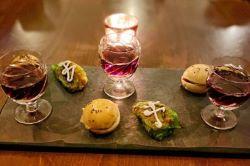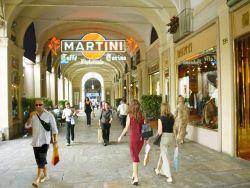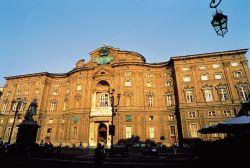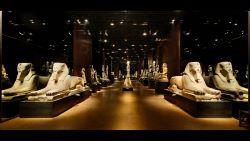INFORMAZIONI SU TORINO
Torino è una città in costante evoluzione: da Augusta Taurinorum (dopo il 27 d.C.) a capitale del Ducato dei Savoia (1563) fino a diventare la prima capitale d'Italia (1861), la regina dell'industria automobilistica (1899) e la protagonista delle Olimpiadi invernali del 2006. Oggi si presenta con un'immagine che la rende ancora più attraente. Torino è una città che aspetta solo di essere scoperta in tutti i suoi molteplici aspetti: ricca di storia, musei, opere d'arte contemporanea en plein air, eventi culturali, con i suoi caratteristici portici, grandi parchi e luoghi magici.
10 BUONI MOTIVI PER VENIRE A TORINO:
- La PRIMA CAPITALE D’ITALIA, prima di Firenze e Roma
- Il MUSEO EGIZIO più antico al mondo
- Il MUSEO NAZIONALE DEL CINEMA all'interno della Mole Antonelliana
- La città che custodisce la SANTA SINDONE
- Le RESIDENZE REALI dichiarate dall'UNESCO Patrimonio dell’Umanità
- La capitale dell’ARTE CONTEMPORANEA
- I migliori CAFFE’ STORICI e PASTICCERIE
- La città che conserva l’AUTORITRATTO DI LEONARDO da Vinci
- La città con 18 km di portici ideali per lo SHOPPING
- La capitale del gusto, del CIOCCOLATO, del VERMOUTH e dei GRISSINI
COSA FARE A TORINO
City Sightseeing Torino
Con l’autobus turistico rosso, scoperto a due piani, si possono ammirare le mille anime della città. I 3 tour disponibili durano circa un’ora l’uno e sono illustrati da un sistema audio digitale multilingue in italiano, francese, inglese, tedesco, spagnolo, russo, cinese, portoghese con possibilità di “sali e scendi” a ogni fermata. È possibile noleggiare il bus per eventi speciali e gruppi preorganizzati.
Merenda Reale®
L'ora della merenda si può trasformare in un piccolo viaggio nel tempo: assapora una Merenda Reale® nei caffè storici o nelle caffetterie delle Residenze Reali aderenti all'iniziativa. Puoi scegliere tra una fumante cioccolata calda o un Bicerin, offerti insieme agli irresistibili "bagnati" e altre specialità al cioccolato o -in estate- il bisquit freddo, sempre accompagnato da raffinate specialità rigorosamente da intingere: torcetti, lingue di gatto e canestrelli.
Torino magica®
Un percorso intrigante e curioso tra volti inquietanti, enigmi massonici e simboli esoterici prende vita attraverso il mistero del Portone del Diavolo, gli spettrali dragoni, la leggenda delle grotte alchemiche, per culminare nella donna velata che regge il calice del Sacro Graal, sotto l’occhio attento dei fantasmi più famosi.
Made in Torino®
Le aziende più prestigiose del territorio aprono le porte per un eccezionale percorso alla scoperta dei metodi e dei segreti che portano alla creazione di un prodotto d’eccellenza: dal mondo dell’automotive all’avventura aerospaziale, dall’emozione del lusso alle tentazioni dell’enogastronomia fino all’arte della stampa.
Extra VermouthTM
Extra Vermouth non è solo una degustazione, è un rituale, un'esperienza unica. Un piacere gastronomico e, allo stesso tempo un'occasione per scoprire il vino aromatizzato apparso alla fine del XVIII secolo alla corte dei Savoia e nelle botteghe dei liquoristi torinesi.

Shopping
Il lungo percorso sotto i portici creato in passato per le passeggiate di casa Savoia nel centro della città è diventato oggi un paradiso assoluto per gli amanti dello shopping. La zona tradizionalmente dedicata allo shopping è compresa tra via Roma, cuore e simbolo della città, e le zone pedonali di via Carlo Alberto e via Lagrange dove brillano le vetrine di tutte le grandi firme della moda e della gioielleria. Via Garibaldi è più giovane e trendy, via Po è più "intellettuale" con le librerie e i negozi di dischi nuovi e usati. Torino ha molti mercati. Il top è quello di Porta Palazzo, il vero cuore multietnico della città. Nelle vicinanze c'è anche il Balôn, lo storico mercato delle pulci.

Nightlife
Quando il tramonto scalda la città e le luci si accendono è il momento di organizzare la serata: un allegro aperitivo in uno dei tanti locali del centro, una deliziosa cena a base di cibi tradizionali o etnici... e poi la notte torinese ti aspetta!
Piazza Vittorio Veneto, Borgo Dora e il Quartiere Romano - il vero centro della città - ospitano molti locali di tendenza: qui arte, cibo e design rendono l'atmosfera ancora più frizzante, si ascolta musica classica, pop e jazz rigorosamente dal vivo, si chiacchiera, si assiste a performance artistiche, si balla fino all'alba. Anche San Salvario ha un fascino irresistibile, il quartiere multietnico (tra la stazione di Porta Nuova e il Parco del Valentino), al centro di un grande progetto di rinnovamento urbano.
Tuttavia, se la vostra idea di serata è più classica, e provate un brivido ogni volta che si alza il sipario, allora lasciatevi incantare dall'opera, dai concerti, dalla danza, dal grande teatro e dalle avanguardie che calcano le scene dei numerosi teatri: il Teatro Regio, l'Auditorium del Lingotto, l'Auditorium RAI, il Teatro Carignano.

COSA VEDERE
MUSEI
La città ospita 42 musei: dal Museo Egizio - il più importante al mondo dopo quello del Cairo - al Museo Nazionale del Cinema nella splendida cornice della Mole Antonelliana, dal Museo d'Arte Antica a Palazzo Madama al Museo Nazionale del Risorgimento Italiano a Palazzo Carignano. La vocazione industriale di Torino ha trovato il suo centro espositivo nel rinnovato Museo Nazionale dell'Automobile MAUTO che racconta la storia automobilistica della città e le problematiche sociali ad essa legate.
Torino è anche un punto di riferimento per l'arte contemporanea: opere e installazioni prodotte negli ultimi trent'anni da artisti di fama internazionale sono esposte all'aperto o in diversi musei e fondazioni come la GAM-Galleria d'Arte Moderna e Contemporanea, il Museo d'Arte Contemporanea del Castello di Rivoli, la Fondazione Sandretto Re Rebaudengo, la Fondazione Merz e la Pinacoteca Giovanni e Marella Agnelli.

RESIDENZE REALI
Conosciuto come la "Corona di Delizie", il gruppo di residenze di Casa Savoia e riconosciute come Patrimonio dell'Umanità dall'UNESCO nel 1997 si presenta come una grande corona se visto dall'alto. La corona è metaforica ma le delizie sono reali. In pieno centro, in piazza Castello, ci sono il maestoso Palazzo Reale - che con la Galleria Sabauda, l'Armeria Reale, la Biblioteca Reale e il Museo Archeologico, formano i Musei Reali - Palazzo Madama e Palazzo Carignano.
Lungo il Po si trova il Castello del Valentino, costruito da Cristina di Francia in stile francese e oggi sede della Facoltà di Architettura del Politecnico di Torino. A poca distanza dal centro, la collina abbraccia Villa della Regina, circondata da giardini all'italiana con padiglioni, fontane e aree agricole. La "corona" è completata da una meravigliosa collezione di castelli e residenze nei dintorni. L'incredibile Palazzo Reale di Venaria ospita oggi grandi eventi, mostre ed eventi nei suoi magnifici interni e nei suoi spettacolari giardini. Uno dei luoghi preferiti dai Savoia per sontuose feste e solenni matrimoni era la Palazzina di Caccia di Stupinigi, modellata sullo stile delle residenze mitteleuropee di costruzione contemporanea.
PRINCIPALI LUOGHI DI CULTO
Dal 1578, il Duomo - unico esempio di arte rinascimentale della città - ospita la Sacra Sindone, il telo che si dice abbia avvolto il corpo di Cristo. Le chiese di Torino non sono solo luoghi di culto, ma anche pregevoli esempi di architettura e arte, soprattutto in stile barocco: la chiesa di San Lorenzo, la prima opera commissionata a Guarino Guarini dalla Corte dei Savoia, le chiese gemelle di Santa Cristina e San Carlo nell'omonima piazza, l'imponente chiesa di San Filippo di Juvarra e la Basilica della Consolata - molto amata dai torinesi - meritano una visita. La nuova chiesa di Santo Volto - opera dell'architetto Botta - è un mirabile esempio di utilizzo di terreni recuperati da ex aree industriali.